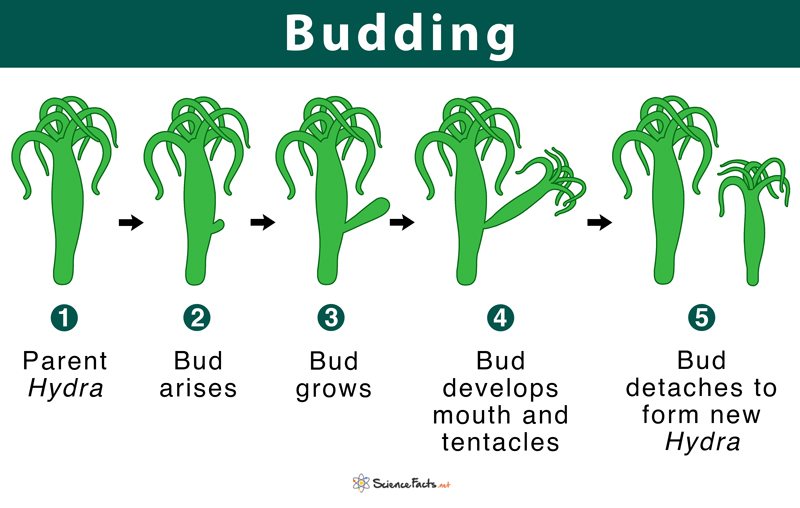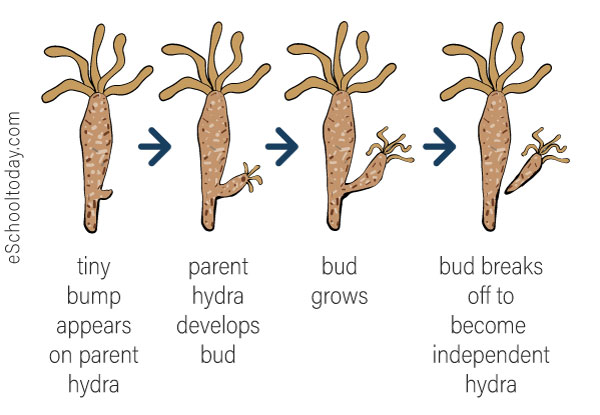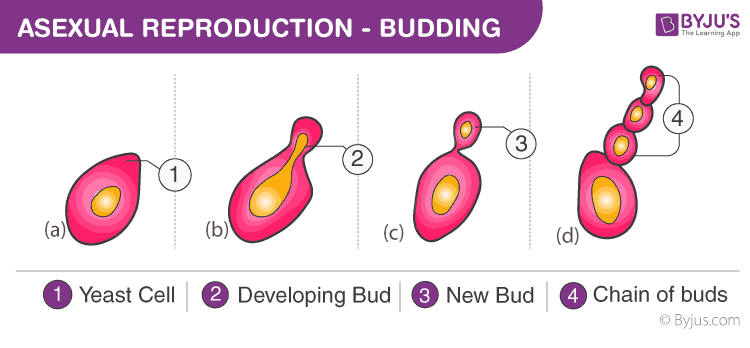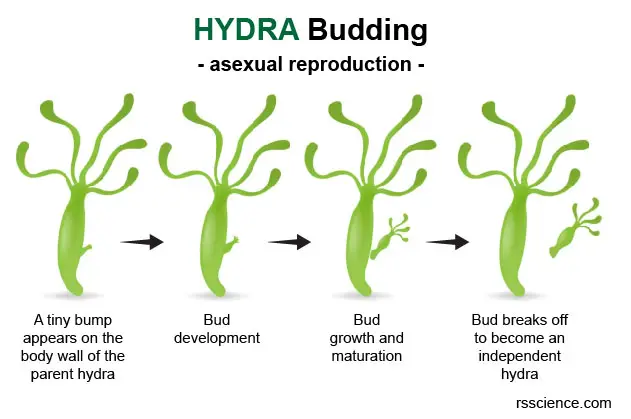Budding: A Deep Dive into Asexual Reproduction

Budding, a fascinating form of asexual reproduction, is a process where a new organism develops from an outgrowth or bud on another. This bud, genetically identical to the parent organism, detaches and matures into an independent entity. Found across a diverse range of life forms, from simple unicellular organisms like yeast to more complex multicellular animals like hydra, budding offers a rapid and efficient method of propagation, particularly in stable and favorable environments.
This article will delve into the intricacies of budding, exploring its mechanisms, variations, advantages, disadvantages, and its significance in the broader context of biological reproduction.
The Mechanics of Budding: A Cellular Perspective
At its core, budding involves a localized proliferation of cells in a specific region of the parent organism. This cellular growth creates a protrusion, the bud, which gradually increases in size and complexity. The process can be broadly divided into the following stages:
- Initiation: The process begins with a signal or trigger, often an environmental cue like ample nutrients or stable temperatures, that stimulates cell division in a localized area of the parent organism.
- Cell Proliferation: Rapid cell division, typically mitosis, occurs within the selected area. This proliferation is carefully regulated to ensure proper development and organization of the emerging bud.
- Bud Formation: The proliferating cells coalesce and form a visible outgrowth or bud. The bud remains attached to the parent organism, receiving nutrients and support.
- Differentiation and Development: Within the bud, cells begin to differentiate and specialize, forming the tissues and organs necessary for independent survival. This developmental process mirrors the embryonic development of sexually produced offspring, albeit on a smaller scale.
- Separation/Detachment: Once the bud has developed sufficiently, it detaches from the parent organism. This separation can occur through various mechanisms, depending on the species. In some cases, the bud simply breaks off, while in others, a specialized abscission layer forms to facilitate clean separation.
- Maturation: The detached bud, now a fully formed individual, continues to mature and grow, eventually reaching reproductive maturity itself.

Variations in Budding Across the Biological Spectrum
While the fundamental principle of budding remains consistent, the specific details of the process can vary significantly across different organisms. This diversity reflects the evolutionary adaptations that have allowed various species to thrive in their respective environments.
Yeast Budding (Unicellular Budding): In single-celled organisms like yeast (Saccharomyces cerevisiae), budding is a relatively simple process. A small outgrowth emerges from the parent cell, and the nucleus divides mitotically, with one daughter nucleus migrating into the bud. The bud grows in size, and eventually, a constriction forms at the base, separating it from the parent cell. A scar remains on the parent cell at the site of each budding event, limiting the number of buds a single cell can produce.
Hydra Budding (Multicellular Budding): In multicellular organisms like hydra, budding is a more complex process involving the coordinated development of multiple cell types. A bud forms on the body wall of the parent hydra, and cells within the bud differentiate to form the various tissues and organs characteristic of a hydra, including tentacles, a hypostome (mouth), and a gastrovascular cavity. Once the bud is sufficiently developed, it detaches and begins its independent life.

Coral Budding (Colonial Budding): Many coral species reproduce asexually through budding, forming large colonies of genetically identical individuals. In this case, the buds don’t always detach completely, leading to the formation of interconnected polyps that share resources. This colonial growth allows corals to efficiently colonize reef environments.
Strobilization (Segmentation Budding): Some animals, like tapeworms and jellyfish, exhibit a form of budding called strobilization. In this process, the body of the organism segments into a series of repeating units called proglottids (in tapeworms) or ephyrae (in jellyfish). Each segment detaches and develops into a new individual, effectively creating a chain of clones.

Advantages and Disadvantages of Budding
Like all reproductive strategies, budding offers certain advantages and disadvantages:
Advantages:
- Rapid Reproduction: Budding allows for rapid population growth in favorable environments. Offspring are produced quickly, without the need for a mate or the complexities of sexual reproduction.
- Energy Efficiency: Budding requires less energy input compared to sexual reproduction, as it doesn’t involve the production of gametes or the energy expenditure associated with courtship and mating.
- Genetic Stability: Budding produces offspring that are genetically identical to the parent organism. This can be advantageous in stable environments where the parent’s genotype is well-suited to the prevailing conditions.
- Colonization of New Environments: Budding can facilitate the rapid colonization of new environments, as a single individual can establish a population without relying on sexual reproduction.
Disadvantages:
- Lack of Genetic Diversity: The absence of genetic recombination in budding results in a lack of genetic diversity within the population. This can make the population more vulnerable to environmental changes or diseases.
- Accumulation of Mutations: Over time, mutations can accumulate in the genome of asexually reproducing organisms. These mutations can be passed on to offspring, potentially leading to a decline in fitness.
- Limited Adaptability: The lack of genetic diversity limits the ability of a population to adapt to changing environmental conditions. If the environment changes drastically, the population may struggle to survive.
- Competition with Parent: Buds developing on the parent organism can compete for resources, potentially hindering the growth and survival of both the parent and the offspring.
The Significance of Budding in Biological Reproduction
Budding plays a significant role in the reproduction and survival of a wide range of organisms. It is particularly important in environments where conditions are stable and favorable, allowing for rapid population growth and efficient resource utilization. Furthermore, budding is crucial in the formation of colonial organisms, such as corals, which play a vital role in marine ecosystems.
In addition to its ecological significance, budding has also been exploited in various biotechnological applications. For example, yeast budding is a crucial process in the production of bread, beer, and wine. Understanding the mechanisms of budding can also provide insights into cell growth, differentiation, and development, which can have implications for understanding and treating diseases like cancer.
FAQ on Budding
Is budding a form of sexual or asexual reproduction?
Budding is a form of asexual reproduction. It does not involve the fusion of gametes (sex cells) and produces offspring that are genetically identical to the parent organism.
What organisms reproduce by budding?
Many organisms reproduce by budding, including yeast, hydra, corals, sponges, and some types of worms.
How is budding different from fragmentation?
In budding, a new organism develops from an outgrowth or bud on the parent organism. In fragmentation, the parent organism breaks into two or more fragments, each of which develops into a new individual.
Why is genetic diversity important?
Genetic diversity allows populations to adapt to changing environmental conditions and increases their resistance to diseases.
Can humans reproduce by budding?
No, humans cannot reproduce by budding. Budding is a form of asexual reproduction that is not found in mammals.
What is the difference between external and internal budding?
External budding is the more common type, where the bud develops on the external surface of the parent organism, like in Hydra. Internal budding, as seen in some sponges, involves the formation of internal buds called gemmules, which are released to form new individuals.
Is budding always beneficial for the organism?
While beneficial in stable environments, budding can be detrimental in rapidly changing conditions due to the lack of genetic diversity. This makes the population vulnerable to new diseases or environmental stressors.
How does budding contribute to coral reef ecosystems?
Budding is a primary method of reproduction for many coral species, enabling the formation of large, interconnected colonies that form the structural foundation of coral reefs.
Conclusion
Budding is a remarkable and diverse form of asexual reproduction that plays a crucial role in the survival and propagation of a wide range of organisms. From the simple budding of yeast cells to the complex colonial budding of corals, this process demonstrates the adaptability and efficiency of asexual reproduction in various ecological contexts. While the lack of genetic diversity can be a disadvantage in changing environments, the rapid reproductive rate and energy efficiency of budding make it a valuable strategy for organisms thriving in stable and favorable conditions. Understanding the intricacies of budding provides valuable insights into the fundamental processes of cell growth, differentiation, and development, and has implications for various biotechnological applications. As we continue to explore the complexities of the natural world, budding remains a fascinating and important area of study.

